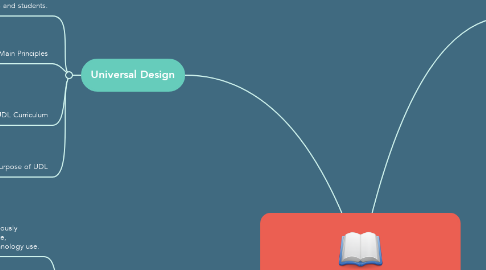
1. Universal Design
1.1. Universal Design for Learning is an educational framework that guides the development of flexible learning environments that can accommodate individual learning differences and students.
1.2. Main Principles
1.2.1. multiple means of representation
1.2.2. multiple means of actions and expressions
1.2.3. multiple means of engagement
1.3. UDL Curriculum
1.3.1. The Universal Design for Learning Curriculum has four parts. These include instructional goals, methods, materials, and assessments.
1.3.1.1. UDL will help inform future curriculum development to ensure learner outcome, resources and assessments better meet the needs of a wider range of students
1.4. Purpose of UDL
1.4.1. The purpose of Universal Design of Learning implementation is to create expert learners.
1.4.1.1. These learners who can assess their own learning needs, monitor their own progress, and regulate and sustain their interest, effort, and persistence during a task
2. Digital Citizenship
2.1. Digital Citizenship is the continuously developing norms of appropriate, responsible, and epowered technology use.
2.2. Framework
2.2.1. Safety
2.2.1.1. Protect Digital Citizens
2.2.1.1.1. While technology affords users new opportunities, the issues that occur are often are the lapses of judgment when the tool is not fully understood. It is important to understand moving to new and different tools when knowledge and rules are not fully established by those who use them.
2.2.2. Savvy
2.2.2.1. Create educated Digital Citizens
2.2.2.1.1. Technology has opened the possibilities of how to learn new skills and aid our responsibility to understand and maximize the potential of these tools.
2.2.3. Social
2.2.3.1. Respect yourself as a Digital Citizen
2.2.3.1.1. This includes creating cooperative and interdependent relationships and the understandings of others. Whether it is through topics of cyberbullying, viewing or posting inappropriate content, or plagiarism, these and other topics of concern that are discussed most among parents and educators.
3. Copyright
3.1. Plagiarism
3.1.1. Using someones else’s words or ideas and pass them off as your own.
3.2. Intellectual Property
3.2.1. Published reports, articles, and content found on web. Must be carefully balanced by rights, licenses, and copyright requirements
3.3. Fair Use
3.3.1. Fair use recognizes that certain uses of the copyright protected work do not require permission form the copyright holder
3.4. Basics of copyrights
3.4.1. Know the rules of the Copyright and protective rights
3.4.1.1. In the United States a copyright holder has exclusive rights to his or her work.
3.4.2. Things protected by Copyright Law
3.4.2.1. Books, magazines, songs, screenplays, podcasts ,online articles, photos artwork, choreography, and software
4. Theoretical Foundations
4.1. Major Foundations
4.1.1. Behaviorism
4.1.1.1. focuses on objectively observable behaviors, and discounts mental activities
4.1.1.2. reflect process of learning into a science
4.1.2. Cognitive Perspectives
4.1.2.1. explain the role of reinforcement
4.1.2.2. explain hidden processes occurring inside learner's brain
4.1.2.3. Categorizing knowledge in attempts to systematize instruction
4.1.3. Constructivism
4.1.3.1. Reflecting on experiences
4.1.3.2. Adjusting our mental models to accommodate new experiences
4.1.3.3. Interaction with information, tools, and materials
4.2. Project Based Learning
4.2.1. Project Based Learning is a teaching and learning model that emphasized student - centered instruction by assigning projects
4.2.1.1. -Focuses on the central concepts of a discipline -Experiences through which students learn to manage and allocate resources
4.3. Inquiry Based Learning
4.3.1. A form of active learning that starts by posing questions, problems, or scenarios.
4.3.1.1. -Creating questions of their own -Obtaining supporting evidence to answer questions -Connecting the explanation to the knowledge -Creating an argument and justification for the explanation
